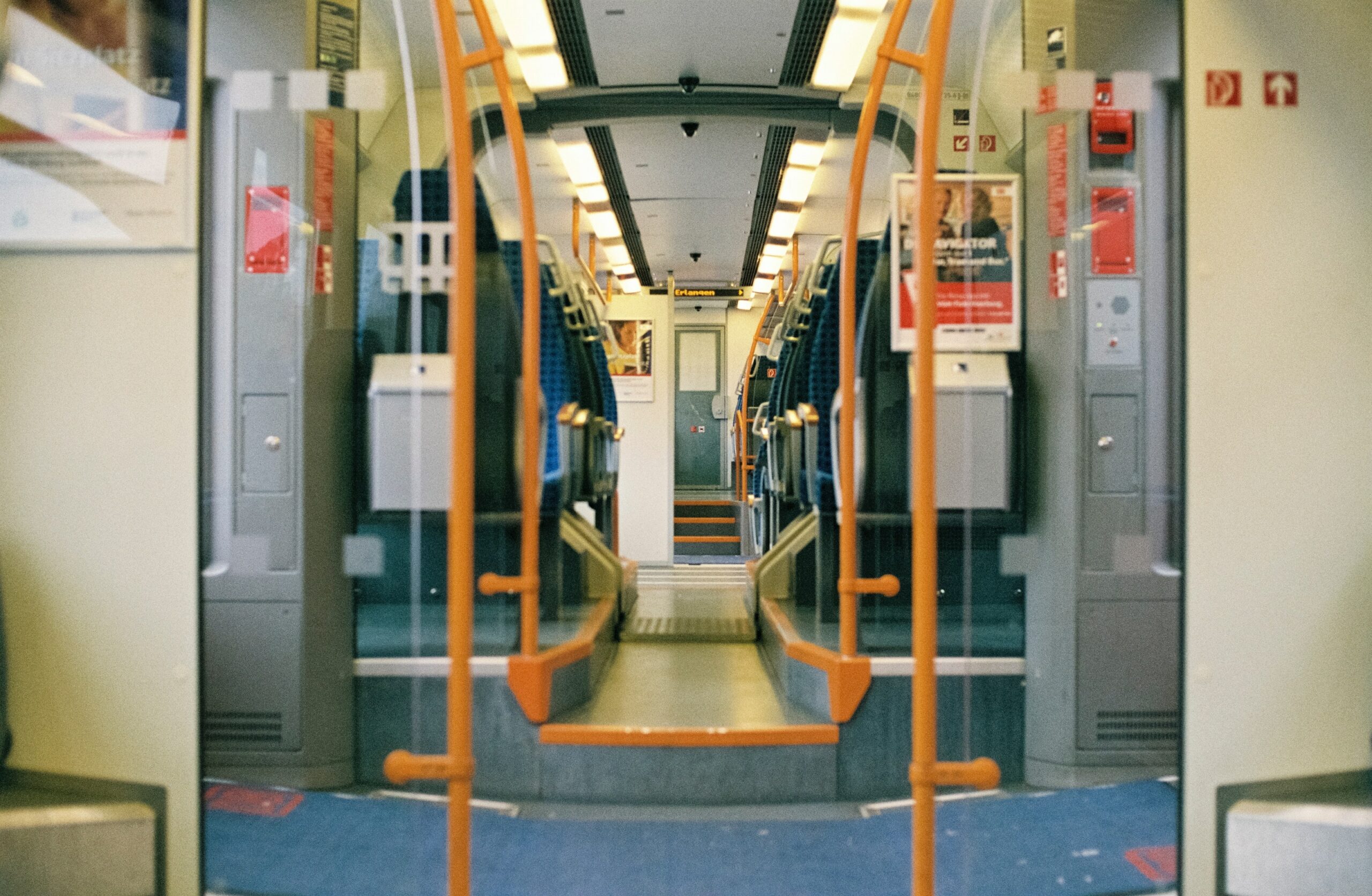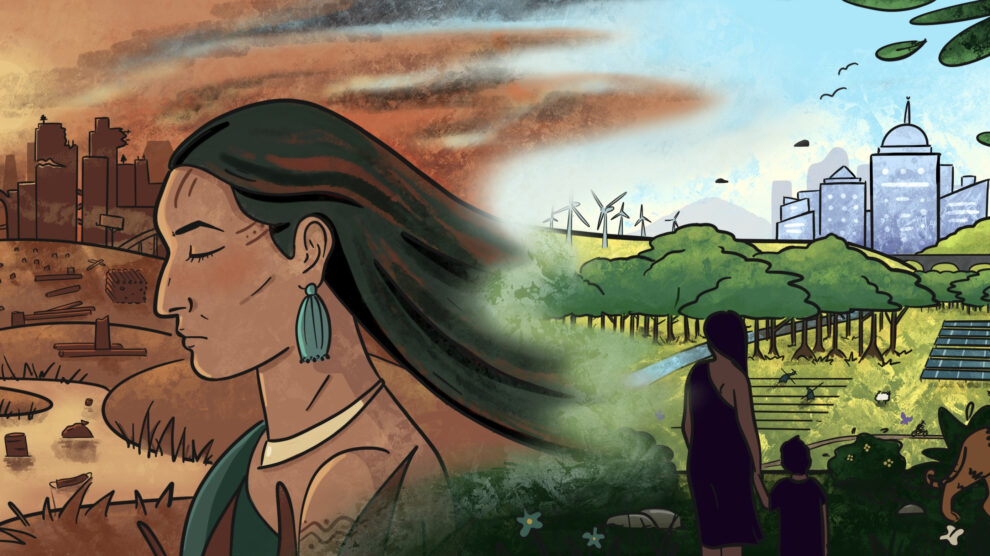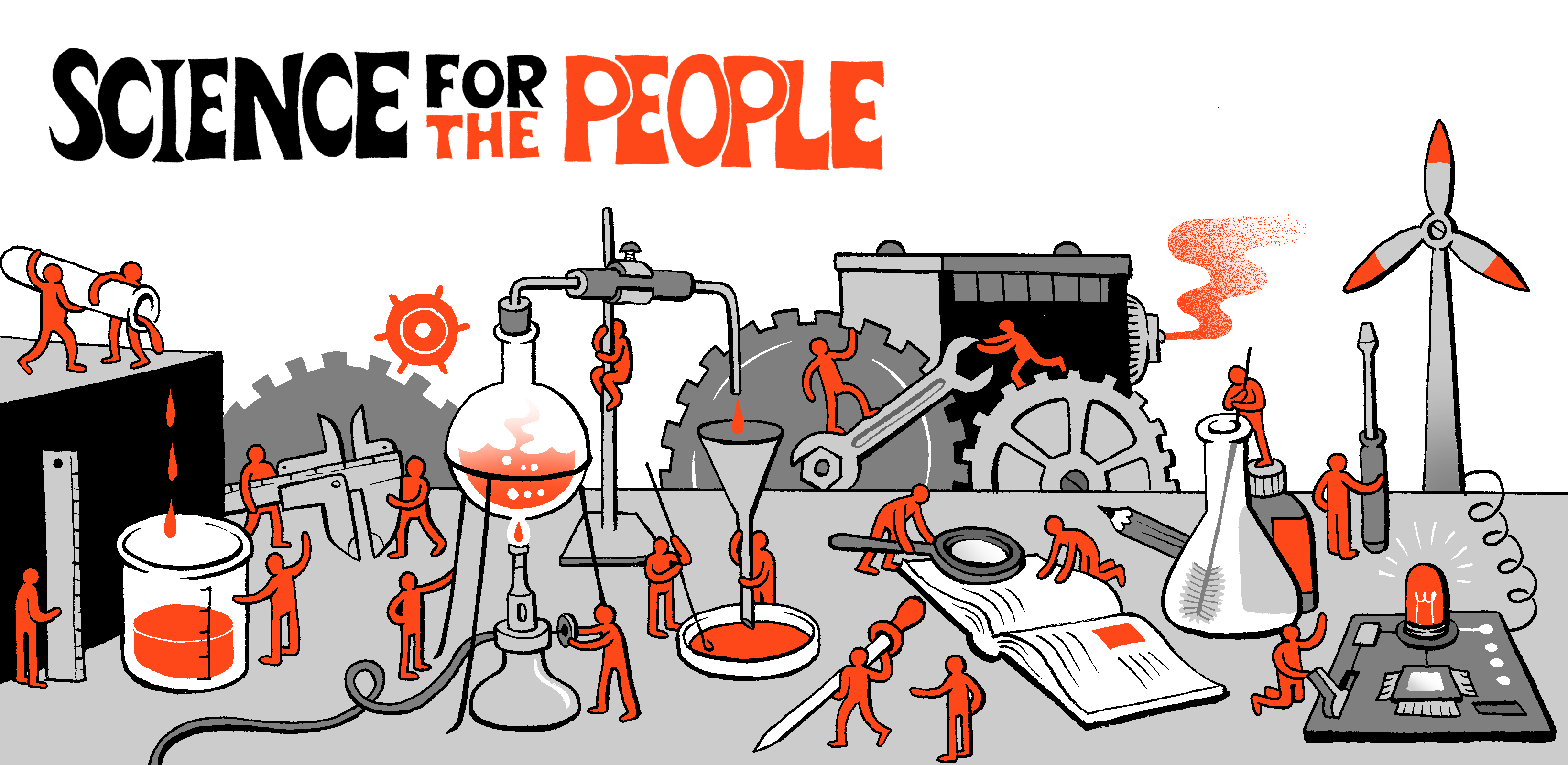Why the Green New Deal Needs Mobility Justice
By Mimi Sheller
Volume 23, number 2, A People’s Green New Deal

Mobility Transitions and Mobility Justice
As COVID-19 sweeps the world, outpacing public health efforts to contain it, many human mobilities are coming to an abrupt halt. As countries seek to recover, will society return to the high-mobility, high-energy, high-carbon economy of the past? Or will we shift to a low-carbon economy, one premised on more resilient, regenerative, and circular forms of local exchange? Could this be the push we need to implement the low-carbon transition that scientists have warned us is necessary? Now is the time to envision, plan, organize, and remake the entire mobility system on a new basis.
We already have many low-carbon “mobility transition” policies—meaning a structural transformation of transportation through technology, physical infrastructure, markets, regulation and governance, cultural values, and user practices toward greater environmental sustainability.1Transportation is one of the hardest sectors to decarbonize.2 A century of government subsidization of the automobile and fossil fuel industries has driven urban sprawl, white flight, suburbanization, and the development of urban expressways that plowed through minority communities while choking off funding for public transit.3 Now, the Green New Deal (GND) offers an unprecedented stimulus to change the way America moves.
Unequal mobility regimes and high rates of automobile dependence are not just “green” issues; they also contribute to racial injustice, gender and sexual inequality, health disparities, and the exclusion of people of diverse abilities from public space.
To move beyond automobile dependence, some cities have embraced investments in urban rail expansion, electric trams, bus rapid transit and bus priority lanes, protected bike lanes and cycle ways, publicly available charging networks for electric vehicles, and shared bike and micro-mobility systems such as e-scooters.4 Nevertheless, what John Urry called the prevailing “system of automobility” remains dominant in the United States and worldwide, shaping our built environment, our cities, and how most people move around.5 Urry argued that cities were remade to fit the car, bolstered in the US through vast New Deal road building programs, subsidies for fossil fuel extraction on public land, and tax breaks for car manufacturers. This system of automobility is not just a means of transportation, but an interlocking system of social practices, industrial and business networks, and ongoing relations between mobility, energy production, consumption, and land use, intertwined in a complex system that is heavily influenced by powerful mobility regimes that work in the interest of “kinetic elites.”6Kinetic elites are the groups with the greatest capabilities for multiple forms of mobility, and who benefit most from the system of private, individualized freedom of mobility, while imposing its risks and environmental burdens on the mobility poor.
The GND proposes a wide range of far-reaching policies to accelerate the shift toward low-carbon transportation. As part of a transition to 100 percent renewable energy by 2030, the Ocasio-Cortez/Markey House Resolution 109 calls for 100 percent zero emission passenger vehicles by 2030, and 100 percent fossil-free transportation by 2050. They propose phasing out internal combustion engine vehicles (ICEVs) across the entire vehicle fleet, building electric charging infrastructure across the country to support a transition to electric vehicles (EVs), accelerating the development of alternative fuel vehicles such as hydrogen fuel cells, and replacing some air travel with high speed rail.7
We need to expand the social and political terrain upon which GND transportation policies are conceived and developed, and strengthen their commitments to mobility justice.
The transformative potential of this infrastructure investment is enormous. Yet many of the proposed policies are market-based, consumer-oriented, and industry-incentivizing. Other GND policies for transportation are proposed in Kate Aronoff et al.’s A Planet to Win (2019), including free access to transit, public ownership of public transit, unionized workers building electric buses, shared micro-mobility for the last mile, improved public ride-hailing services for local mobility, plus more bullet trains, regional rail, subways, and streetcars. These ideas at least pay more attention to unions, public ownership, and cost subsidies than the House Resolution. However, they still overlook many of the entrenched inequities in the transportation system and transportation planning. Instead, we need to expand the social and political terrain upon which GND transportation policies are conceived and developed, and strengthen their commitments to mobility justice.8
Movements such as The Untokening, People for Mobility Justice, and Equiticity, call attention to the biases that persist in low-carbon transport planning, including by GND advocates. The Covid-19 pandemic has made this even more urgent, when we see low-income essential workers and transit workers, many of whom are racial and ethnic minorities, being disproportionately exposed to infection.9 The Untokening, a “multiracial collective that centers the experiences of marginalized communities to address mobility justice and equity,” held “convenings” in Atlanta (2016), Los Angeles (2017), Detroit (2018), and Durham (2019).10They developed “Principles of Mobility Justice” through these community-based discussion processes: “Mobility Justice demands that we fully excavate, recognize, and reconcile the historical and current injustices experienced by communities—with impacted communities given space and resources to envision and implement planning models and political advocacy on streets and mobility that actively work to address historical and current injustices experienced by communities.”11
Unequal mobility regimes and high rates of automobile dependence are not just “green” issues; they also contribute to racial injustice, gender and sexual inequality, health disparities, and the exclusion of people of diverse abilities from public space. It is time for a People’s Green New Deal (PGND) that is both sustainable and equitable. In fact, we cannot have “green” mobility without mobility justice.12
Towards a People’s Green New Deal for Mobility Justice
Traditional forms of transport planning, engineering, and infrastructure financing disfavor the perspectives, experiences, and needs of people who are not white, male, able-bodied and middle class.13 “Green” transport planning seems to suffer from the same problem. Some low-carbon transport policies have actually exacerbated mobility injustices. For example, transit-oriented development, which aims to design urban places to bring people, activities, buildings, and public space together, with easy walking and cycling connection between them, is sometimes associated with rising property prices and displacement of historical minority communities. When bike lanes come with gentrification, they risk becoming “white lanes.”14 Melody Hoffman and Adonia Lugo argue that bike infrastructure policies that seek to attract the “creative class” to cities like Minneapolis or Los Angeles can end up undermining bicycle mobility for those outside of the creative classes.15
At the same time, policies such as phasing out internal combustion private vehicles through taxation, using congestion charging, eliminating parking, and imposing carbon pricing will place a heavy cost on lower-income yet car-dependent communities who are priced out of desirable city-centers. Electric vehicle charging infrastructure is perceived as serving only the wealthy private car-owners who can afford new EVs. And high-speed rail, however desirable, is extremely expensive and may be cost-prohibitive for many potential passengers. Meanwhile, Vision Zero policies, which have sought to reduce vehicular crashes and their associated deaths and injuries, have also attracted criticism from racial and ethnic minority groups who feel these policies lead to excessive policing of Black and Brown communities. Do Lee has shown how the policing of “good” bicycling has been especially detrimental to immigrant bike delivery riders, who are fined for various reasons or have their e-bikes impounded.16
How can a PGND help advance both sustainable mobility and mobility justice? Mobility justice advocate Tamika Butler, former Executive Director of the LA Bicycle Coalition, centralizes race, identity, and power in planning the future of transportation. Planners must move past top-down planning models and work with communities to build infrastructure that is envisioned and designed by the people it serves, especially disinvested communities of color. We need to extend GND policies beyond thinking about transportation in isolation and move toward a more comprehensive, interconnected approach to mobility justice. A strong PGND must be radically grounded in repairing past and ongoing harms to Black, Indigenous, People of Color (BIPOC) communities, as well as attending to the needs of women, children, the elderly, people with disabilities, and people with diverse gender identities.
This framework calls for a PGND that explicitly works to overcome the chronic disinvestment in communities of color, dismantle the race and class barriers to mobility, and repair the devastating impact of past highway building, segregation, white flight, and uneven health impacts of transport inequity, such as exposure to air pollution. It means recognizing the harmful impacts of mobility policing, from “manner of walking” offenses used to justify stop and frisk policies, to the excessive traffic stops for “Driving While Black” (or Brown, or Indigenous).17 It requires thinking about transportation as a way to connect marginalized communities with opportunities after a long history of using transportation in America to actively marginalize racialized communities. As Jason Henderson argues, Atlanta’s contentious automobility debates led to “secessionist automobility,” which “is bound with the blunt politics of race-based secession from urban space, but also more subtle forms of spatial secession rooted in anti-urban ideologies.” And as Kafui Attoh argues in Rights in Transit, “For those who lack other means of mobility, transit is a lifeline. It offers access to many of the entitlements we take as essential: food, employment, and democratic public life itself.”18
Who is doing transport planning matters: we need to call out color-, gender-, ability-insensitive transport planning if we want to build inclusive, cross-racial, multiethnic, all-gender, all-abilities access to low-carbon mobilities. How can we democratize transportation planning within the GND? Some cities and planning agencies are starting to support and foster a pipeline of more diverse talent of Black, Asian, and Latinx planners, engineers, and professionals. BIPOC communities are also organizing and developing initiatives to advance mobility justice and transform the built environment. Groups like The Untokening, Equiticity, and People for Mobility Justice are helping center equity and justice at the core of transportation planning. They demand, “that new decision-making systems and structures are created by and for these communities to center their visions and cultivate operating principles that align with their values and lived experiences. . . . Decision-making processes must meet communities where they are, and embrace full leadership from these communities—not in ratifying or amending pre-ordained ideas but building new ways of interacting and sharing power.”19 The Untokening has released reflections and recommendations on Mobility Justice and COVID-19, and with Pueblo Planning hosted a series of Transformative Talks to “share ideas, uplift community-based narratives and strategies, and create a healing space for BIPOC community leaders, advocates and practitioners engaged in mobility justice.”20
“Seek to Repair Harm, Not Erase History”
How can under-represented and under-invested communities, labor and trade unions, women and care workers, and social movements be involved in planning for sustainable mobility futures? Data for Progress released a report in 2020 on “A Green New Deal for City and Suburban Transportation” which calls for major investments in transit-friendly streets, prioritizing roadway maintenance over expansion, ensuring a “just transition” that creates secure, well-paying jobs, and weighting EV incentive programs by income, geography and vehicle size, including a call for a $50 billion annual federal investment in transit.21 They note that every $1 billion invested in public transit creates more than 50,000 jobs, and “the supply chain for public transportation touches every corner of the country and employs thousands” of people.22This is precisely the kind of investment that will pull our country out of the pandemic-generated recession.
Stephen Higashide argues that better bus systems will create better cities for all citizens. When the consequences of subpar transit service fall most heavily on the most vulnerable members of society, then transit systems should be redesigned to be inclusive and provide better service for all. Bus networks can be redrawn with bus-only priority lanes and better real-time information, improving service frequency, speed, and convenience, while also reducing car-use and making streets safer for all users. Any social mobilization for a strong PGND must partner with transportation labor unions to leverage power. As labor organizer Kim Kelly puts it, “Delivery drivers and transit workers are perfectly positioned to pull down—hard—on the levers of power… Transportation workers hold the keys to the economy and to our society at large; without them, nothing and nobody can get where they need to go—no matter how important they believe themselves to be.”23
A strong PGND must consider how we can prevent “low-carbon gentrification” in our cities, as well as “climate colonialism” abroad such as the mining of metals on Indigenous lands. We must think about the local embodied interactions of public space, streets, and transit, as well as the transnational relations of resource extraction and energy circulation that underpin large-scale infrastructure transitions. Responses to the climate crisis and to environmental injustices should include not only a shift to non-carbon fuels and new electric infrastructure (the main current policy proposals), but also a critical stance involving more socially just forms of life, new material assemblages of mobilities, and more equitable distributions of infrastructure, clean energy, public transit, and affordable housing.24
Unequal and differential mobilities drive ecological harm, environmental injustice, climate injustice, and unsustainable societies serving the interests of the capitalist kinetic elite. Through more inclusive and democratic transportation planning–putting decision making and ownership in the hands of the workers and communities who have been most harmed by the dominant system of automobility and unequal infrastructure—we can perhaps come out of this crisis with a more just and sustainable world.
About the Author
Mimi Sheller, PhD is a Professor of Sociology and founding Director of the Center for Mobilities Research and Policy at Drexel University in Philadelphia. She is founding co-editor of the journal Mobilities and past President of the International Association for the History of Transport, Traffic and Mobility. She is author of twelve books, including Mobility Justice: The Politics of Movement in an Age of Extremes (Verso, 2018) and the forthcoming Island Futures: Caribbean Survival in the Anthropocene (Duke University Press, 2020). Mimi can be found on Twitter at @mCenterDrexel.
References
- Tim Schwanen, “Low-carbon Mobility in London: A Just Transition,” One Earth 2, no. 2 (February 2020): 132-34, https://www.cell.com/one-earth/fulltext/S2590-3322(20)30046-4.
- US Environmental Protection Agency, “Fast Facts on Transportation Greenhouse Gas Emissions,” (June 2019), 1-4.
- Robert D. Bullard and Glenn S. Johnson, eds., Just Transportation: Dismantling Race and Class Barriers to Mobility (Gabriola Island, BC: New Society Publishers, 1997); Robert D. Bullard, Glenn S. Johnson, and Angel O. Torres, “Dismantling Transportation Apartheid: The Quest for Equity” in Sprawl City, ed. R. Bullard, G. Johnson and A. Torres (Washington, DC: Island Press, 2000), 39-68; R. Bullard, G. Johnson, and A. Torres, Highway Robbery: Transportation Racism and New Routes to Equity (Cambridge: South End Press, 2004); Michael K. Brown, M. Carnoy, E. Currie, T. Duster et al., White-Washing Race: The Myth of a Color-Blind Society (Berkeley: University of California Press, 2003).
- Peter Newman and Jeffrey Kenworthy, The End of Automobile Dependence: How Cities are Moving Beyond Car-Based Planning (Washington, DC: Island Press, 2015).
- John Urry, “The ‘System’ of Automobility,” Theory, Culture & Society 21, nos. 4-5 (2004): 25-39; Mimi Sheller and John Urry, “The City and The Car,” International Journal of Urban and Regional Research 24, no. 4 (2000): 737-57.
- John Urry, Mobilities (Cambridge: Polity Press, 2007); Mimi Sheller, Mobility Justice: The Politics of Movement in an Age of Extremes (London and New York: Verso, 2018).
- H. Res. 109 – “Recognizing the Duty of the Federal Government to Create a Green New Deal,” February 7, 2019. https://www.congress.gov/bill/116th-congress/house-resolution/109
- Mimi Sheller, “Racialized Mobility Transitions in Philadelphia: Urban Sustainability and the Problem of Transport Inequality,” City and Society 27, no. 1 (April 2015): 70-91.
- Lois Beckett, “Revealed: Nearly 100 US Transit Workers Have Died of Covid-19 Amid Lack of Basic Protections,” The Guardian, April 20, 2020, https://www.theguardian.com/world/2020/apr/20/us-bus-drivers-lack-life-saving-basic-protections-transit-worker-deaths-coronavirus
- The Untokening, “Principles of Mobility Justice 1.0” (2017), untokening.org; and see Peopleformobilityjustice.org and Equiticity.org.
- The Untokening, “Principles”
- Sheller, Mobility Justice.
- Adonia E. Lugo, Bicycle/Race: Transportation, Culture, & Resistance (Portland: Microcosm Publishing, 2018).
- Melody Hoffmann, Bike Lanes are White Lanes: Bicycle Advocacy and Urban Planning (Omaha: University of Nebraska Press, 2016); John G. Stehlin, Cyclescapes of the Unequal City: Bicycle Infrastructure and Uneven Development (Minneapolis: University of Minnesota Press, 2019).
- Melody Hoffmann and Adonia Lugo, “Who is ‘world class’? Transportation justice and bicycle policy,” Urbanities 4, no. 1 (2014): 45-61; Stehlin, Cyclescapes of the Unequal City.
- Do Lee et al., “Delivering (in)justice: Food delivery cyclists in New York City” in Bicycle Justice and Urban Transformation: Biking for all? ed. Aaron Golub, Melody L. Hoffmann, Adonia E. Lugo, Gerardo F. Sandoval (London: Routledge, 2016), 114-129.
- Paul Gilroy, “Driving While Black,” in Car Cultures, ed. Daniel Miller (Oxford and New York: Berg, 2001), 81-104; Gretchen Sorin, Driving While Black: African American Travel and the Road to Civil Rights (New York: Liveright Publishing Corp., 2020).
- Jason Henderson, “Secessionist Automobility; Racism, Anti-Urbanism, and the Politics of Automobility in Atlanta, Georgia,” International Journal of Urban and Regional Research 30, no. 2 (2006): 293; Kafui Attoh, Rights in Transit: Public Transportation and the Right to the City in California’s East Bay (Athens: University of Georgia Press, 2019); Genevieve Carpio, Collisions at the Crossroads: How Place and Mobility Make Race (Oakland: University of California Press, 2019).
- See untokening.org/updates/2017/11/11/untokening-10-principles-of-mobility-justice
- See See untokening.org/webinars and untokening.org/updates/2020/4/8/mobility-justice-and-covid-19.
- Steven Higashide, Billy Fleming, Hayley Richardson, Emily Mangan, Scott Goldstein, Ben Fried, Ashley Pryce, Natalee Rivera, Daniel Aldana Cohen, Xan Lillehei, Katie Lample, Nick Graetz, and Julian Brave NoiseCat, A Green New Deal for City and Suburban Transportation (Data for Progress, March 2020), https://www.dataforprogress.org/memos/3/17/gnd-city-suburban-transportation.
- Steven Higashide et al., “A Green New Deal,” 11.
- Stephen Higashide, Better Buses, Better Cities: How to Plan, Run and Win the Fight for effective Transit (Washington, DC: Island Press, 2019); Kim Kelly, “Planes, Trains and Automobiles,” The Baffler, November 27, 2019, https://thebaffler.com/working-stiff/planes-trains-and-automobiles-kelly; Mindy Isser, “Striking Bus Drivers Steer the Way to a Better World,” In These Times, May 5, 2020. http://inthesetimes.com/working/entry/22506/bus_drivers_strike_workers_covid_climate_crisis
- Sheller, Mobility Justice; Mimi Sheller, Aluminum Dreams: The Making of Light Modernity (Cambridge: MIT Press, 2014); Thea Riofrancos, Resource Radicals: From Petro-Nationalism to Post-Extractivism in Ecuador (Durham and London: Duke University Press, 2020).





